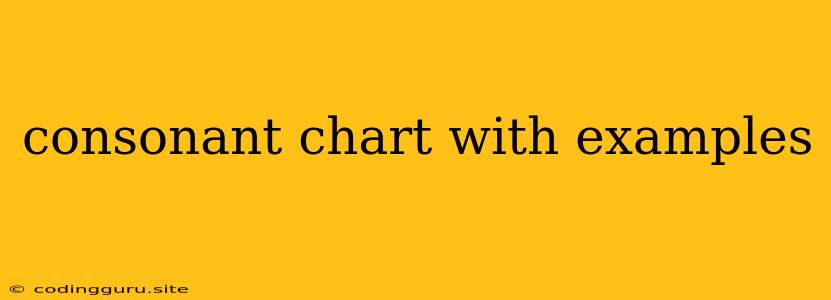What are Consonants?
Consonants are speech sounds that are produced by obstructing the airflow in the mouth. Unlike vowels, which are produced with an open mouth, consonants involve the tongue, teeth, or lips coming together to create a blockage. This blockage can be partial or complete, resulting in a variety of sounds.
The Consonant Chart: A Visual Guide
The consonant chart is a visual representation of the consonant sounds in a language. It organizes these sounds based on various features, such as:
- Place of articulation: Where in the mouth the obstruction occurs (e.g., lips, teeth, palate).
- Manner of articulation: How the airflow is obstructed (e.g., stopping, fricating, approximating).
- Voicing: Whether the vocal cords vibrate during the sound production (voiced) or not (voiceless).
Understanding the Chart:
The chart is often laid out in a grid format, with the horizontal axis representing the place of articulation and the vertical axis representing the manner of articulation. Each cell in the grid represents a specific consonant sound.
Places of Articulation:
- Bilabial: Sounds produced with both lips (e.g., p, b, m)
- Labiodental: Sounds produced with the lower lip against the upper teeth (e.g., f, v)
- Dental: Sounds produced with the tongue tip against the upper teeth (e.g., θ, ð)
- Alveolar: Sounds produced with the tongue tip against the alveolar ridge (the bony bump just behind your upper teeth) (e.g., t, d, s, z, n, l, r)
- Post-alveolar: Sounds produced with the tongue blade just behind the alveolar ridge (e.g., ʃ, ʒ, tʃ, dʒ)
- Palatal: Sounds produced with the tongue against the hard palate (the roof of your mouth) (e.g., j, ŋ)
- Velar: Sounds produced with the back of the tongue against the soft palate (the back part of the roof of your mouth) (e.g., k, g)
- Glottal: Sounds produced at the vocal cords (e.g., h)
Manners of Articulation:
- Stops: Sounds produced by completely blocking the airflow and then releasing it suddenly (e.g., p, b, t, d, k, g)
- Fricatives: Sounds produced by partially obstructing the airflow, creating a friction sound (e.g., f, v, θ, ð, s, z, ʃ, ʒ, h)
- Affricates: Sounds that begin as stops and then release into fricatives (e.g., tʃ, dʒ)
- Nasals: Sounds produced by allowing air to flow out through the nose (e.g., m, n, ŋ)
- Liquids: Sounds produced with the tongue tip touching the roof of the mouth, but allowing air to flow around it (e.g., l, r)
- Glides: Sounds produced with minimal obstruction, allowing air to flow smoothly (e.g., w, j)
Voicing:
- Voiceless: Sounds produced without vocal cord vibration (e.g., p, t, k, f, s, ʃ, θ, h)
- Voiced: Sounds produced with vocal cord vibration (e.g., b, d, g, v, z, ʒ, ð, w, j, m, n, l, r, ŋ)
Examples of Consonants:
Here are some examples of consonants and their corresponding categories:
| Consonant | Place of Articulation | Manner of Articulation | Voicing |
|---|---|---|---|
| p | Bilabial | Stop | Voiceless |
| b | Bilabial | Stop | Voiced |
| t | Alveolar | Stop | Voiceless |
| d | Alveolar | Stop | Voiced |
| k | Velar | Stop | Voiceless |
| g | Velar | Stop | Voiced |
| f | Labiodental | Fricative | Voiceless |
| v | Labiodental | Fricative | Voiced |
| s | Alveolar | Fricative | Voiceless |
| z | Alveolar | Fricative | Voiced |
| ʃ | Post-alveolar | Fricative | Voiceless |
| ʒ | Post-alveolar | Fricative | Voiced |
| θ | Dental | Fricative | Voiceless |
| ð | Dental | Fricative | Voiced |
| h | Glottal | Fricative | Voiceless |
| m | Bilabial | Nasal | Voiced |
| n | Alveolar | Nasal | Voiced |
| ŋ | Velar | Nasal | Voiced |
| l | Alveolar | Liquid | Voiced |
| r | Alveolar | Liquid | Voiced |
| w | Bilabial | Glide | Voiced |
| j | Palatal | Glide | Voiced |
| tʃ | Post-alveolar | Affricate | Voiceless |
| dʒ | Post-alveolar | Affricate | Voiced |
The Importance of Consonants:
Consonants play a crucial role in speech and language. They provide clarity and distinction between words, allowing us to understand and communicate effectively. They also contribute to the rhythm and intonation of spoken language, adding nuances and expression.
Using the Consonant Chart:
Understanding the consonant chart can be beneficial for:
- Learning a new language: It helps visualize the sounds and their production, making it easier to pronounce words accurately.
- Improving pronunciation: By analyzing the place, manner, and voicing of consonants, you can identify and correct any pronunciation errors.
- Speech therapy: Therapists use the chart to understand and address speech difficulties related to consonant production.
- Linguistic analysis: Researchers utilize the chart to study the sounds of various languages and explore their similarities and differences.
Conclusion:
The consonant chart is a valuable tool for understanding and exploring consonant sounds. By understanding its organization and categories, you can gain a deeper appreciation for the complexities of speech and language. Whether you are learning a new language, improving your pronunciation, or simply curious about the building blocks of speech, the consonant chart provides a helpful and insightful guide.
